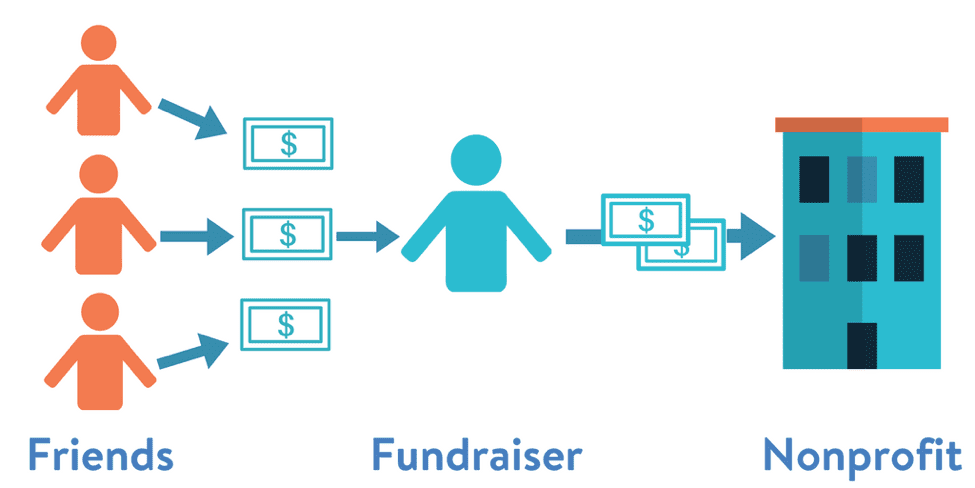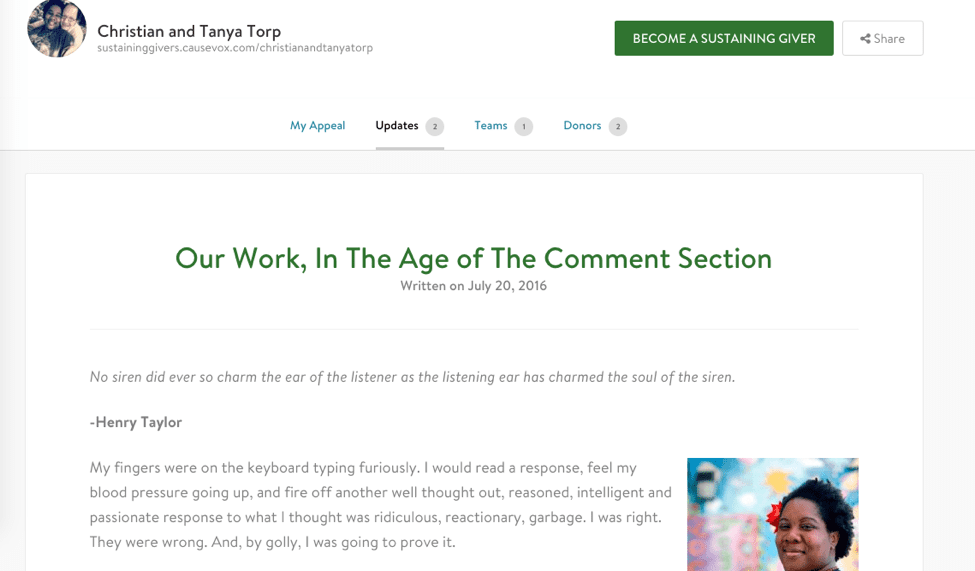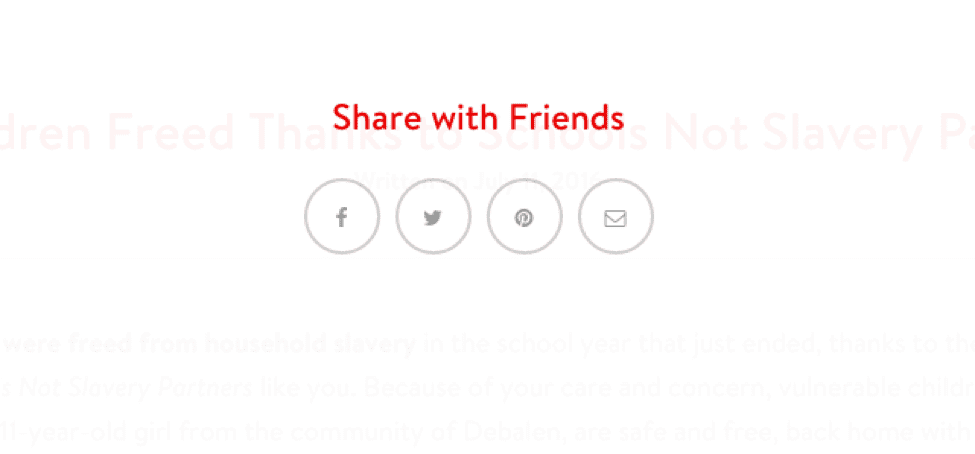Introduction
Ever so often, you’re bound to run across a cause that truly moves you. Maybe it’s after you saw a nonprofit’s beautiful and emotion-inducing photo on Instagram or a fascinating story on Facebook. Or, you may have talked to a friend or family member connected to a nonprofit or charity that is changing lives, which prompted you to learn more.
You send in a donation, tell your own friends and family about the cause, but you feel inclined to do more.
So why not help the cause by fundraising for it? After all, people who are passionate about a cause make great personal fundraisers!
But, what does it mean to be a personal fundraiser? Let’s start with the basics.
Peer-to-Peer Fundraising

Peer-to-peer fundraising is a powerful type of crowdfunding that where individuals with a passion for a cause can raise money on behalf of a nonprofit or charity. These people (you!) are personal fundraisers.
Aside from raising funds for a nonprofit or charity, your job as a personal fundraiser is to open the hearts and minds of your friends and family to the cause. You’re in a unique position to reach potential donors that the nonprofit or charity wouldn’t necessarily have access to on their own.
As a personal fundraiser, you have power- and this power lies in word-of-mouth marketing.
Nearly ⅓ of all online donations are a result of peer-to-peer fundraising, likely because your closest friends, family, coworkers, and even people you’re connected to on social media but haven’t seen since middle school inherently trust you a whole lot more than, say, a random advertisement. If you trust and support a cause, your friends are more likely to follow suit.
When all’s said and done, your fundraising efforts will combine with the efforts of other loyal supporters to help a cause that you’re passionate about. It’s a win-win for everyone involved!
Your Personal Fundraising Story
Once you decide to be a personal fundraiser, you’ll be prompted to create a personal fundraising page. During this step, consider what your story will be.
You may be wondering what we mean by story. After all, you may feel as though you are simply fundraising under an organization’s umbrella. But, this is not the case. Your page’s audience will need to know exactly why YOU are campaigning for this particular cause.
The key to raising funds is not just giving potential donors an avenue to give (which is definitely important), but by making them feel emotionally invested in the cause.
This guide will outline what a story is and what it needs to accomplish, summarize storytelling basics, and introduce a formula for success that will help you as you create your own story for your fundraising page.
Figuring Out Your Story
Stories are essential in fundraising because they’re usually what motivates people to give a donation. As a personal fundraiser, you’ll use your own story to:
- Educate friends, family, coworkers, and even your online acquaintances about a cause that you’re passionate about.
- Get them excited about being part of the movement like you are
- Encourage them to get involved by following your call to action.
Start your storytelling process by thinking about what motivated you to get involved.
Understanding Your Involvement
In personal fundraising, your story often begins with how you got involved with the cause.
Use these prompts to start connecting your personal relationship with the organization to the cause it supports.
- Describe your relationship with the organization/umbrella campaign
- What drives you to participate in the campaign?
- What do this campaign’s goals represent to you?
- At what moment did you feel compelled to join the cause?
- Was there a particular instance or story that compelled you to act?
- Was there an experience in your life when you particularly empathized with this cause?
Remember that your audience will be eager to understand the WHY. Why this organization? Why did you get involved? Why is this cause worth the money and time? Therefore, it’s important to establish your connection to the organization upfront.
Think About How The Cause Makes You Feel
Next, you’ll want to get in the mindset of a potential donor. To do this, take a step back and think about how this cause made YOU feel when you were first introduced to it.
Use your responses from the questions above (about your involvement/connection to the organization) to figure out what emotions you want to share with your audience.
For example, you may have been inspired to become a personal fundraiser after viewing an unforgettable Instagram image posted on the nonprofit or charity’s website. Therefore, you may want to describe the emotions you felt after initially seeing the picture in order to encourage your audience to develop or feel those same emotions.
A good, moving story doesn’t necessarily have to make people feel one way over another. Your audience will be moved to act whether they feel sad, happy, hopeful, or in awe- just as long as it’s genuine.
Understanding the Cause
Getting your friends and family onboard as donors will probably take more effort than simply telling them why you support the organization and getting them emotionally invested. They also need to understand the cause itself.
In order to understand the cause and problem that the campaign is trying to resolve, you must thoroughly research the organization you are supporting. Read their mission statement and any supporting organizational documentation. Then, study the specifics of this particular campaign.
- What is the overall goal for the campaign?
- What will reaching this goal do to further the organization’s mission?
Once you understand the goal, outline your contribution to the overall goal by asking yourself the following questions:
- What is your personal goal toward the campaign total?
- What will reaching your goal to do further the organization’s mission?
Now that you have a good understanding of the problem your personal fundraising campaign is hoping to address, it’s time to discuss how you will get your audience to relate to the problem and become part of the solution.
What Do You Want Your Audience To Do?
Once you outline exactly what encouraged you to act, consider what will prompt others to do likewise. After all, you will not meet your fundraising goals without compelling others to be a part of the solution. You must get your potential donors to respond to your story.
Now is the time to revisit your contribution to the overall campaign goal. Donors to your personal fundraising page will want to know your personal fundraising goal, so know exactly:
- How much you need from your donors
- The impact of that dollar amount (such as in lives changed or other return on investment)
You’ll use all this great information to formulate your call to action- the statement that get’s results!
We’ll discuss a formula to writing the perfect call to action later in this tutorial.
Storytelling Basics
Hopefully, you now have a good idea of the goal of your story and what you will need to express it in order to bring in much-needed donations. But wait- there’s more!
If you want to express your story in a way that not only emphasizes a need for support but that encourages donors to act, follow these tried-and-true tips.
Language
Readers need clear yet descriptive stories. The material must be insightful and cohesive.
Stories should be written in 1st and 2nd person and rely heavily on the I, you, your, and yours pronouns. This is because 1st and 2nd person portray a personal tone. This language pulls the reader into the story, leaving them feeling as though they are part of your journey.
Audience
Your audience will be potential donors who view your personal fundraising page- most likely your network of friends, family, and colleagues. All language (as explained above) should be tailored to this audience. Because, in most cases, you know all of these people personally, it’s best to be casual.
Medium
There are a handful of ways to express your story. The most common method on a personal fundraising page is through a written word, but photos and videos are also successfully used to support your story, especially in peer-to-peer fundraising campaigns.
- Written Story: The written word is exceptionally impactful if it is clear, focused, and comes from the heart. It is the best medium to use when you are describing your personal relationship with the organization or mission.
- Video: Videos are a great tool to use when you want to express a story from the point of view of a client or someone impacted by the work of the organization. Videos are perfect when you wish to express emotionally resonant material that you may not be able to put into words or to add a personal interview dimension to it.
- Photos: Humans are naturally wired to respond to visual stimuli. After all, we all know that “a picture is worth more than a thousand words.” Choose pictures that are inspirational, educational, and relevant. Pictures of human faces work best.
- Other Mediums: These include voice recordings and artistic representations. If the cause has influenced you to express yourself with art, this may be something you want to share with your audience.
Length
The length of your story will depend on the medium used. Consider following these guidelines:
- Written Story: 175-400 words is best. If your story goes over this allotment, just be sure that is purposefully written.
- Video or Voice Recording: 1-2 minutes
- Photos or Artwork: 1 impactful picture with or without motivating statistics or quotes
In short, your story should be personal, clear, urgent, complete, unique, interesting, relatable, and actionable. Phew! Now, let’s get started with the truly fun part- creating your content.
Putting It All Together
We have discussed in-depth the reasons why a good story is necessary for your personal fundraising page and what information it should include. You have also learned about some of the basics of storytelling.
Now that you know what the story should accomplish, it is time to bring it all together to share it with your friends and family.
Introduction and Status Quo
Use your story introduction to give your audience a sense of who you are and how you are tied to the organization.
Your introduction may include content related to one or more of these prompts:
- Explain your relationship to the organization (as discussed above)
- Describe the client or person being served by the organization in a way that will relate to your audience based on your research and knowledge of the cause.
- Illustrate where they live, their family, what their day-to-day looks like.
- If possible, explain that person’s goals and desires. What makes them tick?
So how do you put this in context for your own personal story? Take a look at this example by Michael Gabriel’s Sweat for She’s the First campaign:
Not long ago, my good friend Brooke Oliver and her friend Erin Leigh started “26 Miles for 26 Girls”. Teaming up with She’s the First, they made a goal of raising enough money together so each mile they ran in the Georgia Marathon covered the education of a girl in Nepal for an entire year. After pulling that off in spades, Erin then ran another full marathon and did it again!
Earlier this year, I got selected in the lottery for the New York City Marathon on my first attempt. I was so impressed with what Brooke and Erin accomplished that it didn’t take much to convince me when Brooke asked me to consider using the NYC Marathon as an opportunity to support She’s the First.
Michael provides a great backstory in this example. He explains his relationship with friends that raised funds for the organization and how their successes fueled his desire to help. We also learn the purpose of his campaign (to fund a year of education for girls in Nepal).
Describe the Problem/Situation/Need
Next, describe what happened to cause the problem or need. This part doesn’t necessarily have to be dark, gloomy, or depressing, but it should get the reader to stop and think.
Formulate your story’s problem with these questions/prompts:
- What is causing a change from the status quo?
- Why do you as a personal fundraiser feel compelled to help?
- If you were motivated after witnessing the problem/situation/need firsthand, then describe when you decided that this was a cause worth fighting for.
If appropriate, use ‘feeling’ words to describe the struggle or need. These can include:
- Positive- brave, lucky, calm, spirited, sympathetic
- Negative- doubtful, upset, powerless, hesitant, vulnerable
A great example of describing the need and motivating factors behind the fundraiser’s actions comes from Villy Wang with BAYCAT.
BAYCAT is that dream come true, and it’s an honor to build a community that creates positive social change through storytelling. But the youth we have to turn away, and those that struggle through challenges amplified by social inequities are the reasons why I stay awake at night.
Help our youth thrive. Help me sleep better.
Wow! Not only do we learn about the problem (turning youth away because of a lack of funding, youth struggling because of social inequities) from Villy’s words, we also understand her own struggle and motivation to act for the cause.
She also uses extremely powerful language such as “…are the reasons why I stay awake at night” and “Help me sleep better.” It is impossible not to feel her suffering.
Since this section is key to getting your audience emotionally invested in a good outcome, let’s take a look at one more example.
Experiencing Operation Baby Rescue firsthand broke my heart. I’ll never forget seeing Blanca Olivia swinging helpless in a hammock. The quiet sound of her whimpering was enough to pierce any heart. No screaming or crying… Her body was giving up. The devastating effects of dirty water and malnutrition had put too much of a fight for this little girl to handle… At World Help, we talk a lot about saving lives. But for the first time, I was literally holding that life in my arms. A life that would be rescued because we had chosen to come, because we cared, and because we were moved to action.
Noel Brewer Yeatts, the author of this piece and fundraiser for Operation Baby Rescue, does a perfect job of presenting the problem. She speaks from her own experience in describing this scene in heart-wrenching detail. We understand the problem and why she was moved to act (a sick child made worse by dirty water and malnutrition).
Explain What Is Needed To Solve The Problem
You’ve set up the problem, now begin to detail the steps that need to take place in order to solve the problem. This section should be bright and optimistic. Describe:
- What the organization is working toward
- What those impacted by the organization will experience if they get the assistance they need.
- Make the donation seem relatable.
- How donating to this cause will help your donor make a big impact
Remember, the donor needs to be able to visualize a happy ending. They also need to see themselves the ‘hero’ of the story. Use positive and reaffirming language. Your donor CAN do something and change will occur BECAUSE OF THEM.
Let’s look at a great example of a personal fundraising story that discusses solving the problem. Leonie Dupuis created a personal fundraising page for She’s the First, the nonprofit mentioned above that sponsors education for females across the world. She writes:
In countries She’s the First is involved with, 2 out of 3 girls won’t even graduate high school. This doesn’t seem fair to me. I want every girl in the world to have a chance to fall in love with learning like I have… She’s the First helps girls break the cycle of poverty and become role models for their families and friends as they become the first in their family to obtain a secondary education.
In this statement, Leonie explains both what the organization is working toward (high school education for girls, breaking the cycle of poverty) and what those impacted by the organization (the girls they serve) will experience if they get assistance (falling in love with learning, moving out of poverty, becoming role models).
Leonie uses powerful phrases such as “I want” and “fall in love” to make the reader understand her passion for the cause.
For you and I, all it takes is skipping Starbucks for a couple days, eating in instead of dining out, or maybe even painting your own nails. Life is full of rewards, but the best rewards come from giving back.
Then, Leonie makes the goal relatable to the donor (suggesting giving up coffee-to-go, manicures, and frequenting restaurants). Finally, she concludes with how the donor’s life will also be changed for the better after contributing (rewards come from giving back).
Lay Out Your Call To Action and Summary
It’s time to construct a solid and impactful summary and call to action statement to get your audience motivated to donate.
Your summary and call to action should follow this formula:
- Write a short summary (1 or 2 sentences) of the campaign
- Create a sense of urgency in your request
- Use active language in both the summary and the call to action, such as “Click,” “Donate,” and “Share.
Let’s go back to another sample of Villy Wang’s BAYCAT personal fundraising page story.
Help our youth thrive. Help me sleep better. Fund Passion. Not Prison.
We’re so close to our goal, and I’m personally going to put my money where my heart is, and will match every dime I can raise through this personal ask for you to make a significant tax-deductible donation now.
Look at those action words! “Help” and “Fund” are direct calls to action. Villy uses those words to sell the potential donor on the campaign.
Her short summary is clear and concise. “Help our youth thrive. Fund Passion. Not Prison.” She also expresses urgency in her follow-up statement (close to goal).
Here’s another great example of a solid call to action.
My personal goal this year is to raise enough funds to rescue three babies. Will you help me reach this goal?
Here, Noel Brewer Yeatts explicitly states her goal (rescue three babies) and uses a straightforward call to action, “Will you help me reach this goal?” It isn’t pushy, but it is direct.
Don’t Stop At The Fundraising Appeal
Sure, your ultimate goal to to get your friends and family to contribute to your personal fundraising campaign. But, it’s not just about the money raised. Think of each page click or share as another human that learns about the cause you’re fundraising for.
It’s possible that your story may be the fuel that encourages others to get involved- not just as a donor, but as a fundraiser!
Because your personal fundraising story and efforts are so important, be sure to keep your story going past your fundraising appeal. Use the “Updates” feature on your personal fundraising page to continue sharing information about the campaign and cause with your networks.
Here’s a great example from a Kentuckians for the Commonwealth personal fundraising page. In it, fundraisers Christian and Tanya make a case for the cause they’re supporting.

Sharing Your Story
You’ve organized your thoughts and crafted a compelling story destined to motivate your closest friends and family to donate, but that’s all in vain if you don’t get the word out.
Thankfully, the internet has made sharing fundraising campaigns as easy as 1, 2, 3. Here two ways you can share your story:
Start by clicking the “Share” button on your personal fundraising page. Then, select the medium or platform you want to share your campaign on.


- Social Media – Share your personal fundraising page with everyone you’re connected to on social media. Plus, it’s easy for your connections to reshare, retweet, or pin.
- Twitter

- Email – Share your personal fundraising page with your closest friends and family using their email addresses. Be sure to write a personalized message before clicking “Send”!
Storytelling For Personal Fundraisers Summary
First, decide to raise funds on behalf of a cause you’re passionate about as a personal fundraiser. Then, create a personal fundraising page to feature your story.
Your story will include the following sections:
Introduction
- Begin your story by writing about WHY you are involved with the cause. Address:
- Your relationship with the organization
- How you got involved
- Any other information that connects your passions to this campaign
- Describe what emotions you felt when you were motivated to get involved (sad, happy, inspired, disgusted, etc.)
The Problem and/or Need
- Detail the work of the organization you’re campaigning for.
- What do they do?
- Who is impacted by the work?
Solving the Problem
- Goals
- Note your personal fundraising goal
- Note the goal of the overarching campaign
The Call to Action and Summary
- Summarize the campaign in 1 to 2 sentences
- Then, be specific about what you’re looking for from your friends and family.
- Specify desired gift amount (if applicable)
- Describe the impact of that gift (in lives changed, return on investment, etc.)
- Use active words such as “Donate” or “Give”
Final Checklist
____ Is your story written in 1st or 2nd person?
____ Is your story written as though you are having a discussion with your audience?
____ Are you using an effective storytelling medium such as written word, images, videos, or art?
____ Have you followed the storytelling best practices of being personal, clear, urgent, complete, unique, interesting, relatable, and actionable?
____ Do you plan to follow up with donors via a blog or other fundraising page updates?
____ Have you shared your personal fundraising page with friends and family on social media and through email?
Conclusion
Hopefully, you are bursting at the seams and ready to create your own unique story for your personal fundraising page. Here are a few last things to keep in mind as you begin the process.
The most successful personal fundraisers can explain why they are involved in the campaign, the work that is being done, and their goals, as well as the overall goal of the organization. A good story will include all of this in an emotionally-compelling yet clear manner. Support your story with a moving photo or short video clip to put a face behind your campaign.
Once the donations start coming in, be sure to personally communicate with your donors. Thank them for their support and consider addressing the direct impact their donation had such as in lives served or return on investment.




